Study on Shielding Effectiveness of High Transmittance Coating Film Glasses against Electromagnetic Pulse
Abstract
:1. Introduction
2. Typical EMP Waveform Characteristics
2.1. EMP Waveform
2.2. EMP Frequency Coverage and Frequency Domain Energy Distribution
3. Shielding Effectiveness
3.1. Fundamentals of SE
3.2. Absorption Attenuation
3.3. Reflection Attenuation
3.4. Multiple Reflection Attenuation
3.5. Protective Benefits of Shielding Attenuation
4. Experimental Setup and Results
4.1. Experimental Setup
4.2. Far Field Regions of an Antenna
- Reactive near field: This field is a near-field region close to the antenna aperture in the antenna radiation field. The transformation between the electric and magnetic fields is similar to the transformation between the electric and magnetic fields in a transformer and manifests as reactive energy storage. The field usually covers the area between the antenna aperture surface to /2 away from the antenna. The boundary condition of this field is as follows:
- Near field: This field is also called the Fresnel zone; it is located between the reactive near field and the far field. The electromagnetic field is at a distance from an antenna and enters the air in the form of an electromagnetic wave. The boundaries of the far field and the near field are defined by the distance between transmitting and receiving antennas. In this region, the reactive field effect is substantially lower than that of the radiation field. The radiation pattern and angle change with antenna distance. The boundary of the region is as follows:
- Far field: This field is also called the Fraunhofer zone; its location ranges from outside the near field to infinity. The reactive field no longer exerts any effect in this field, and the radiation pattern is unrelated to distance change. The radiation field transmitted from any point of the antenna must have a phase difference of lower than /8 when it reaches the observation point. The far field condition is as follows:
4.3. Shielding Effectiveness of Shielded Room
4.4. Resistivity and Transmittance of Coating Tempered Glasses Measurements
4.5. Shielding Effectiveness of Coating Tempered Glasses
5. Conclusions
- The conductive-coated glass samples had ∼ (S/cm) conductivity (); the resistivity () was reduced down to ; and the light transmittance was 74% or higher. At a frequency band of 20 kHz∼100 MHz, the glass samples had the minimum SE of 40 dB and the maximum SE of over 80 dB. At a frequency band of 10 kHz, where shielding is challenging, the SE remained at 31.1 dB or higher. At a frequency band of 100 MHz∼1 GHz, the shielding attenuation decreased gradually; however, SE of at least 32 dB was achieved. These glass materials have practical value as high-transmittance conducive materials for windows of automobiles, vessels, and aircrafts to protect against EMP.
- The electromagnetic SE of conductive-coated glass materials increases with an increase in conductive film thickness. However, the transmittance decreases as film thickness increases. Research is thus warranted to find an optimal combination of the thin film thickness and transmittance.
- Conductive-coated glass and its surrounding metal structure are heterogenous materials. A conductive medium is required to facilitate conductive continuity between the glass and metal structure to achieve effective electromagnetic shielding. The integrative design of a piece of conductive-coated glass, a glass framework, and its surrounding metal structure as well as the selection of materials merit further attention.
- In this study, experiments were conducted to measure the electromagnetic SE of conductive-coated glass materials. Future studies may incorporate numerical simulation analysis into the discussion to facilitate comprehensive and in-depth explorations.
Author Contributions
Funding
Institutional Review Board Statement
Informed Consent Statement
Data Availability Statement
Conflicts of Interest
References
- Hao, R.; Zhang, X.; Gao, H.; Wu, H.; Cheng, J.; Li, G.P. A novel high-altitude electromagnetic pulse (HEMP) protection circuit for RF applications. Microelectron. J. 2019, 84, 1–8. [Google Scholar] [CrossRef]
- Hamamah, F.; Ahmad, W.F.H.W.; Gomes, C.; Isa, M.M.; Homam, M.J. High power microwave devices: Development since 1880. In Proceedings of the 2017 IEEE Asia Pacific Microwave Conference (APMC), Kuala Lumpur, Malaysia, 13–16 November 2017; pp. 825–828. [Google Scholar] [CrossRef]
- Kim, K.; Min, K.R.; Park, Y.J. A Pilot Experiment to Develop a Lightweight Non-Nuclear EMP Shelter Applying Civil-Military Cooperation in a Sustainability Policy. Sustainability 2020, 12, 10669. [Google Scholar] [CrossRef]
- Taflove, A.; Oskooi, A.; Johnson, S.G. Advances in FDTD Computational Electrodynamics: Photonics and Nanotechnology; Artech House: London, UK, 2013. [Google Scholar]
- Wang, C.; Murugadoss, V.; Kong, J.; He, Z.; Mai, X.; Shao, Q.; Chen, Y.; Guo, L.; Liu, C.; Angaiah, S.; et al. Overview of carbon nanostructures and nanocomposites for electromagnetic wave shielding. Carbon 2018, 140, 696–733. [Google Scholar] [CrossRef]
- Yang, C.; Liu, P.G.; Huang, X.J. A Novel Method of Energy Selective Surface for Adaptive HPM/EMP Protection. IEEE Antennas Wirel. Propag. Lett. 2013, 12, 112–115. [Google Scholar] [CrossRef]
- Lu, Z.H.; Liu, P.G.; Huang, X.J. A Novel Three-Dimensional Frequency Selective Structure. IEEE Antennas Wirel. Propag. Lett. 2012, 11, 588–591. [Google Scholar] [CrossRef]
- Holloway, C.; Hill, D.; Ladbury, J.; Koepke, G.; Garzia, R. Shielding effectiveness measurements of materials using nested reverberation chambers. IEEE Trans. Electromagn. Compat. 2003, 45, 350–356. [Google Scholar] [CrossRef]
- Ming, W.; Ming, C. Modeling for electromagnetic pulse shielding effectiveness in time domain. In Proceedings of the 2015 7th Asia-Pacific Conference on Environmental Electromagnetics (CEEM), Hangzhou, China, 4–7 November 2015; pp. 176–179. [Google Scholar] [CrossRef]
- Yan, Z.; Qin, F.; Cai, J.; Zhong, S.; Lin, J. Shielding Performance of Materials Under the Excitation of High-Intensity Transient Electromagnetic Pulse. IEEE Access 2021, 9, 49697–49704. [Google Scholar] [CrossRef]
- Lee, H.S.; Choe, H.B.; Baek, I.Y.; Singh, J.K.; Ismail, M.A. Study on the Shielding Effectiveness of an Arc Thermal Metal Spraying Method against an Electromagnetic Pulse. Materials 2017, 10, 1155. [Google Scholar] [CrossRef] [PubMed]
- Phan, D.T.; Jung, C.W. High Optical Transparent and Shielding Effectiveness Using Metal Mesh and Saltwater for Transparent EMI Shielding Applications. In Proceedings of the 2020 IEEE International Conference on Consumer Electronics-Asia (ICCE-Asia), Seoul, Republic of Korea, 1–3 November 2020; pp. 1–4. [Google Scholar] [CrossRef]
- Greco, S.; Sarto, M.S.; Tamburrano, A. Shielding performances of ITO transparent windows: Theoretical and experimental characterization. In Proceedings of the 2008 International Symposium on Electromagnetic Compatibility—EMC Europe, Hamburg, Germany, 8–12 September 2008; pp. 1–6. [Google Scholar] [CrossRef]
- Grunthaner, F.J.; Grunthaner, P.J.; Maserjian, J. Radiation-Induced Defects in SiO2 as Determined with XPS. IEEE Trans. Nucl. Sci. 1982, 29, 1462–1466. [Google Scholar] [CrossRef]
- Qin, M.J.; Kuo, E.Y.; Whittle, K.R.; Middleburgh, S.C.; Robinson, M.; Marks, N.A.; Lumpkin, G.R. Density and structural effects in the radiation tolerance of TiO2 polymorphs. J. Phys. Condens. Matter 2013, 25, 355402. [Google Scholar] [CrossRef] [PubMed]
- Shablonin, E.; Popov, A.; Prieditis, G.; Vasil’chenko, E.; Lushchik, A. Thermal annealing and transformation of dimer F centers in neutron-irradiated Al2O3 single crystals. J. Nucl. Mater. 2021, 543, 152600. [Google Scholar] [CrossRef]
- Kajal, R.; Kataria, B.; Asokan, K.; Mohan, D. Effects of gamma radiation on structural, optical, and electrical properties of SnO2 thin films. Appl. Surf. Sci. Adv. 2023, 15, 100406. [Google Scholar] [CrossRef]
- Nguyen, L. Conductive Concrete Structures for EMP Protection of Critical Infrastructure Facilities. IEEE Lett. Electromagn. Compat. Pract. Appl. 2019, 1, 26–33. [Google Scholar] [CrossRef]
- Morrow-Jones, J. Nominal High-Altitude Electromagnetic Pulse (HEMP) Waveforms; Technical Report AD1067769; Defense Technical Information Center: Washington, DC, USA, 2019. [Google Scholar]
- Nanevicz, J.; Vance, E.; Radasky, W.; Uman, M.; Soper, G.; Ma Pierre, J. EMP susceptibility insights from aircraft exposure to lightning. IEEE Trans. Electromagn. Compat. 1988, 30, 463–472. [Google Scholar] [CrossRef]
- Bell Telephone Laboratories, L.T.D. EMP Engineering and Design Principles; Bell Laboratories: Hoboken, NJ, USA, 1975. [Google Scholar]
- Ricketts, L.W.; Bridges, J.E.; Miletta, J. EMP Radiation and Protective Techniques; Wiley: New York, NY, USA, 1976. [Google Scholar]
- Hunt, G.; Fisher, W. EMP ship trial, planning, execution and result. In Proceedings of the Seventh International Conference on Electromagnetic Compatibility, York, UK, 28–31 August 1990; pp. 308–317. [Google Scholar]
- Baum, C. From the electromagnetic pulse to high-power electromagnetics. Proc. IEEE 1992, 80, 789–817. [Google Scholar] [CrossRef]
- Weissman, J. Composite and exoatmospheric EMP influence on naval vessels. In Proceedings of the 1992 Regional Symposium on Electromagnetic Compatibility, Tel-Aviv, Israel, 2–5 November 1992; pp. 5.2.1/1–5.2.1/8. [Google Scholar] [CrossRef]
- Leuthäuser, K.D. A Complete EMP Environment Generated by High-Altitude Nuclear Bursts—Data and Standardization; Fraunhofer-Institut für Naturwissenschaftlich-Technische Trendanalysen INT: Euskirchen, Germany, 1994. [Google Scholar]
- Electromagnetic Compatibility (EMC) Including Electromagnetic Pulse (EMP) and Lightning Protection—Fundamentals—Part 10: Threat Levels for NEMP and Lightning; Technical Report VG 95371-10:1995; Bundesamt für Ausrüstung, Informationstechnik und Nutzung der Bundeswehr: Koblenz, Germany, 1995.
- Electromagnetic Compatibility (EMC)—Part 2: Environment—Section 9: Description of HEMP Environment—Radiated Disturbance; Basic EMC Publication; Technical Report IEC 61000-2-9:1996; International Electrotechnical Commission: Geneve, Switzerland, 1996.
- Electromagnetic Environmental Effects Requirements for Systems; Technical Report MIL-STD-464D; Department of Defense: Washington, DC, USA, 2020.
- Evans, R.W. Design Guidelines for Shielding Effectiveness, Current Carrying Capability, and the Enhancement of Conductivity of Composite Materials. In Proceedings of the NASA/CR-4784; NASA Contractor Report 4784; NASA: Washington, DC, USA, 1997. [Google Scholar]
- Klinkenbusch, L. On the shielding effectiveness of enclosures. IEEE Trans. Electromagn. Compat. 2005, 47, 589–601. [Google Scholar] [CrossRef]
- Iqbal, A.; Kwon, J.; Kim, M.K.; Koo, C. MXenes for electromagnetic interference shielding: Experimental and theoretical perspectives. Mater. Today Adv. 2021, 9, 100124. [Google Scholar] [CrossRef]
- Afilipoaei, C.; Teodorescu-Draghicescu, H. A Review over Electromagnetic Shielding Effectiveness of Composite Materials. Proceedings 2020, 63, 23. [Google Scholar] [CrossRef]
- Chung, D. Materials for electromagnetic interference shielding. Mater. Chem. Phys. 2020, 255, 123587. [Google Scholar] [CrossRef]
- High-Altitude Electromagnetic Pulse (HEMP) Protection for Ground-Based C4I Facilities Performing Critical, Time-Urgent Missions; Technical Report MIL-STD-188/125-1; Department of Defense: Washington, DC, USA, 1998.
- Schroder, D.K. Contact Resistance and Schottky Barriers. In Semiconductor Material and Device Characterization; John Wiley & Sons, Ltd.: Hoboken, NJ, USA, 2005; Chapter 3; pp. 127–184. [Google Scholar] [CrossRef]

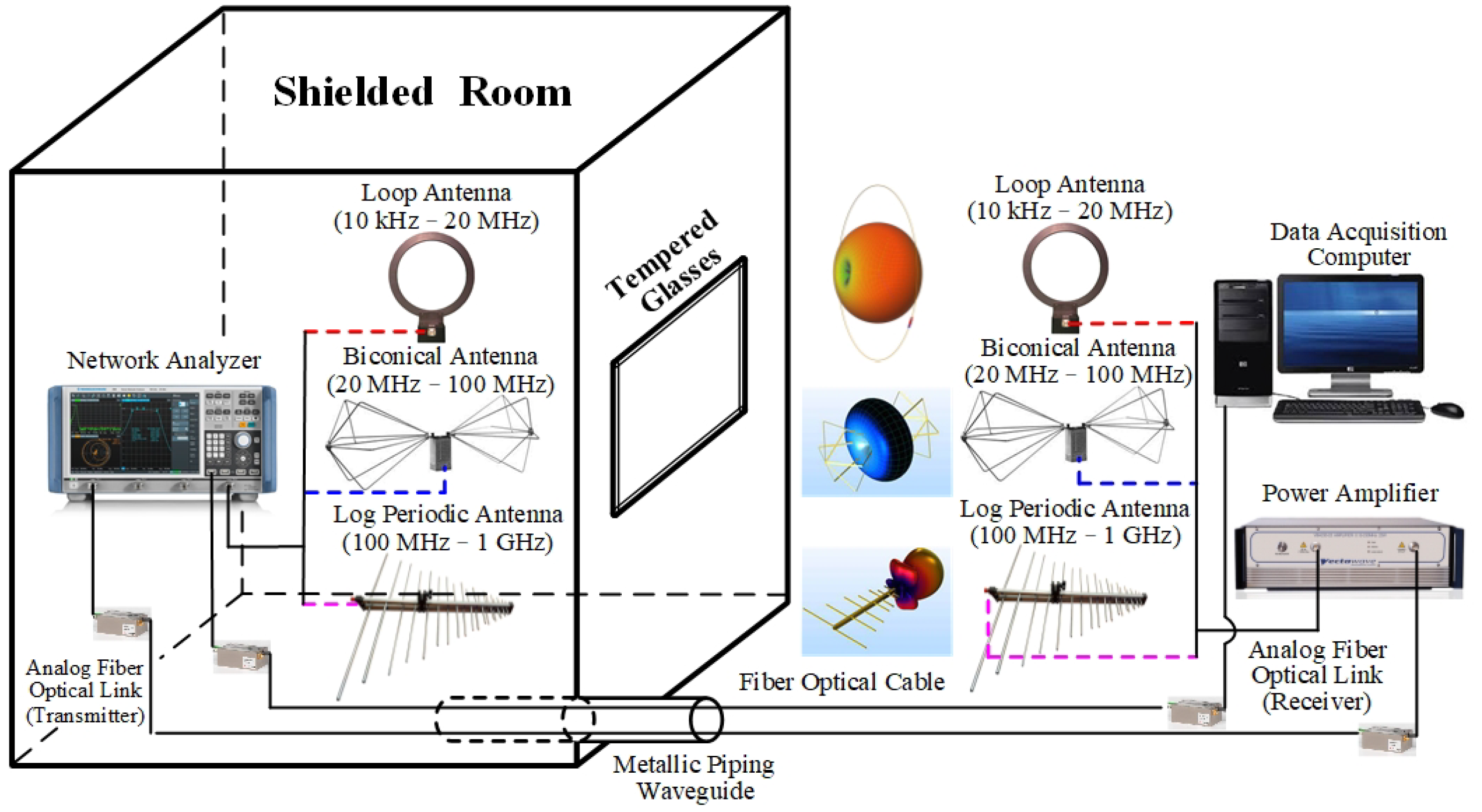

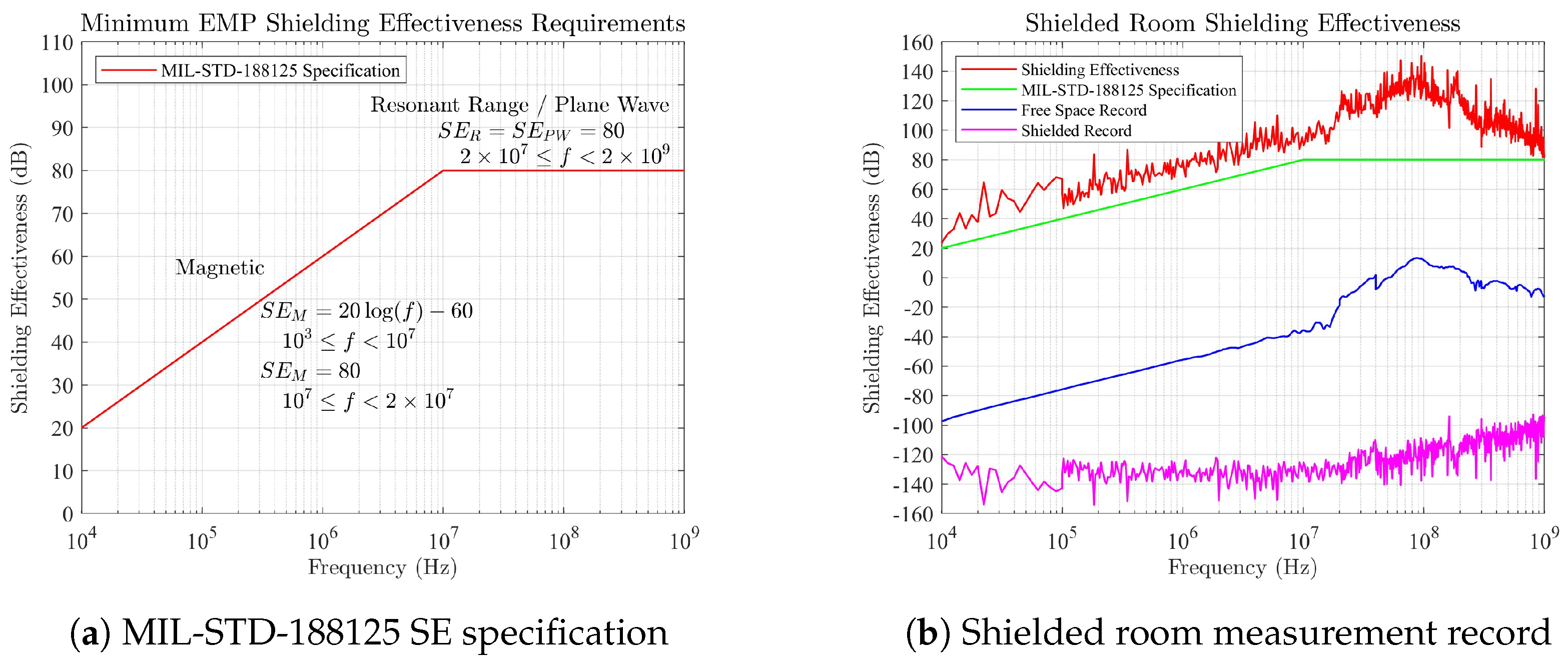
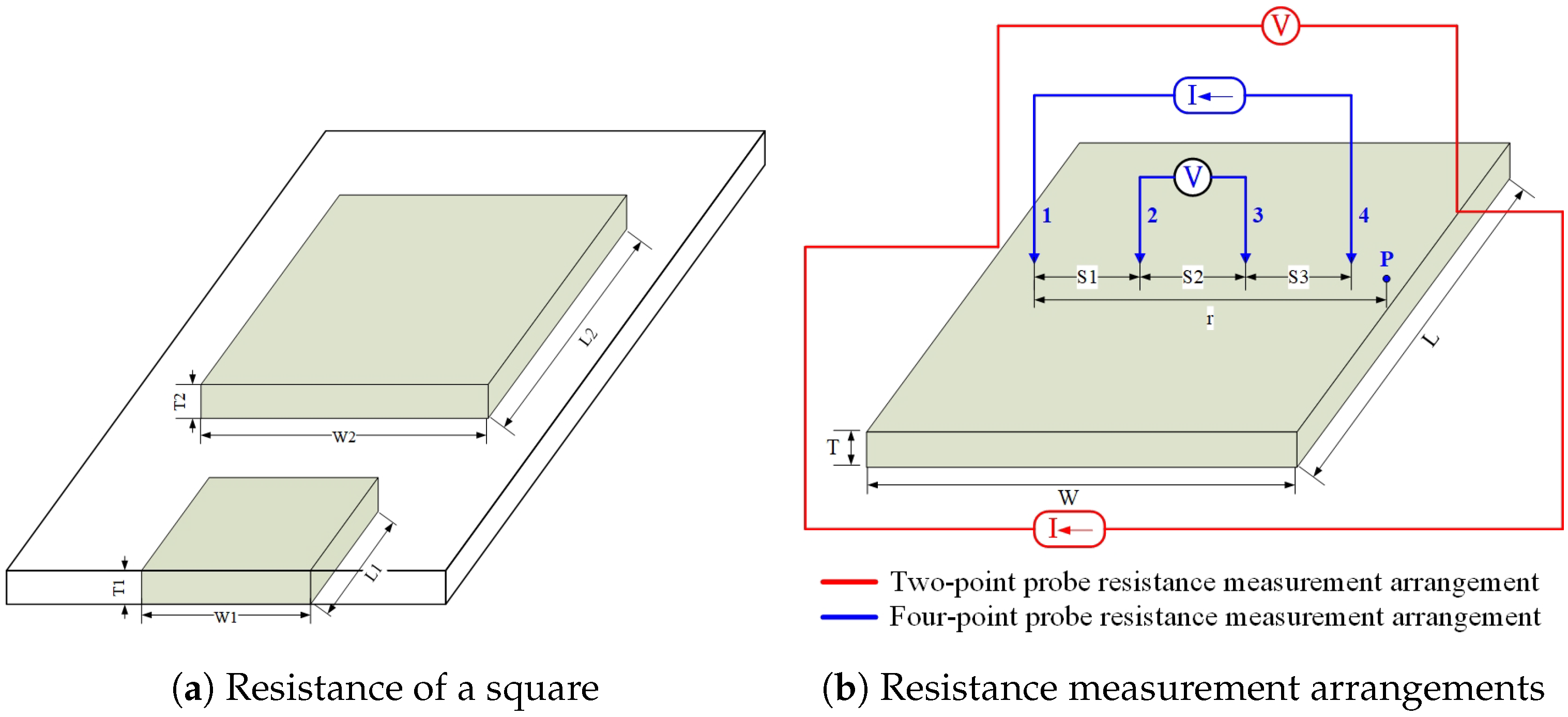
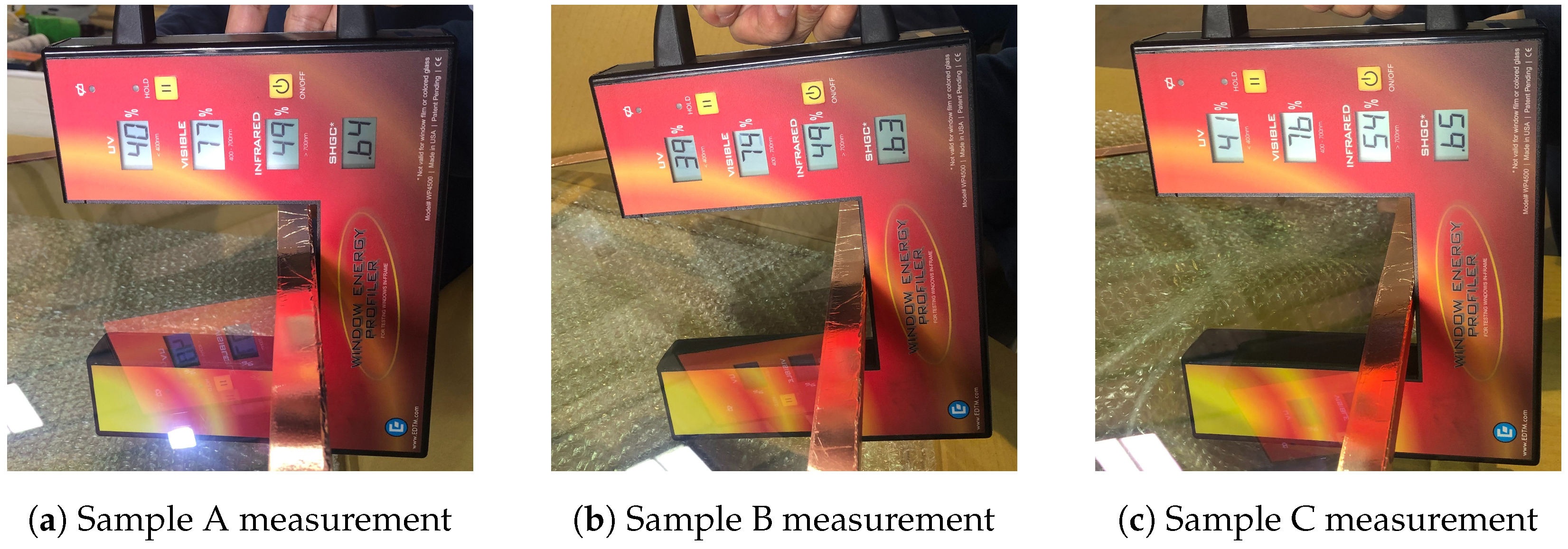
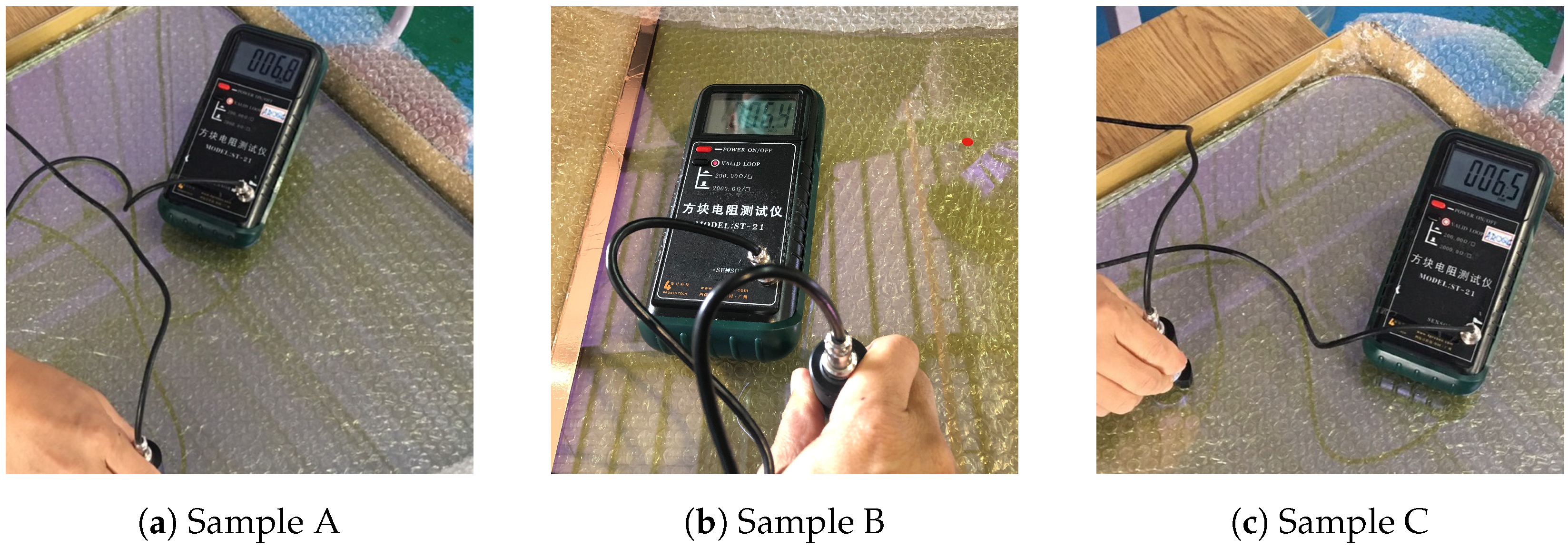
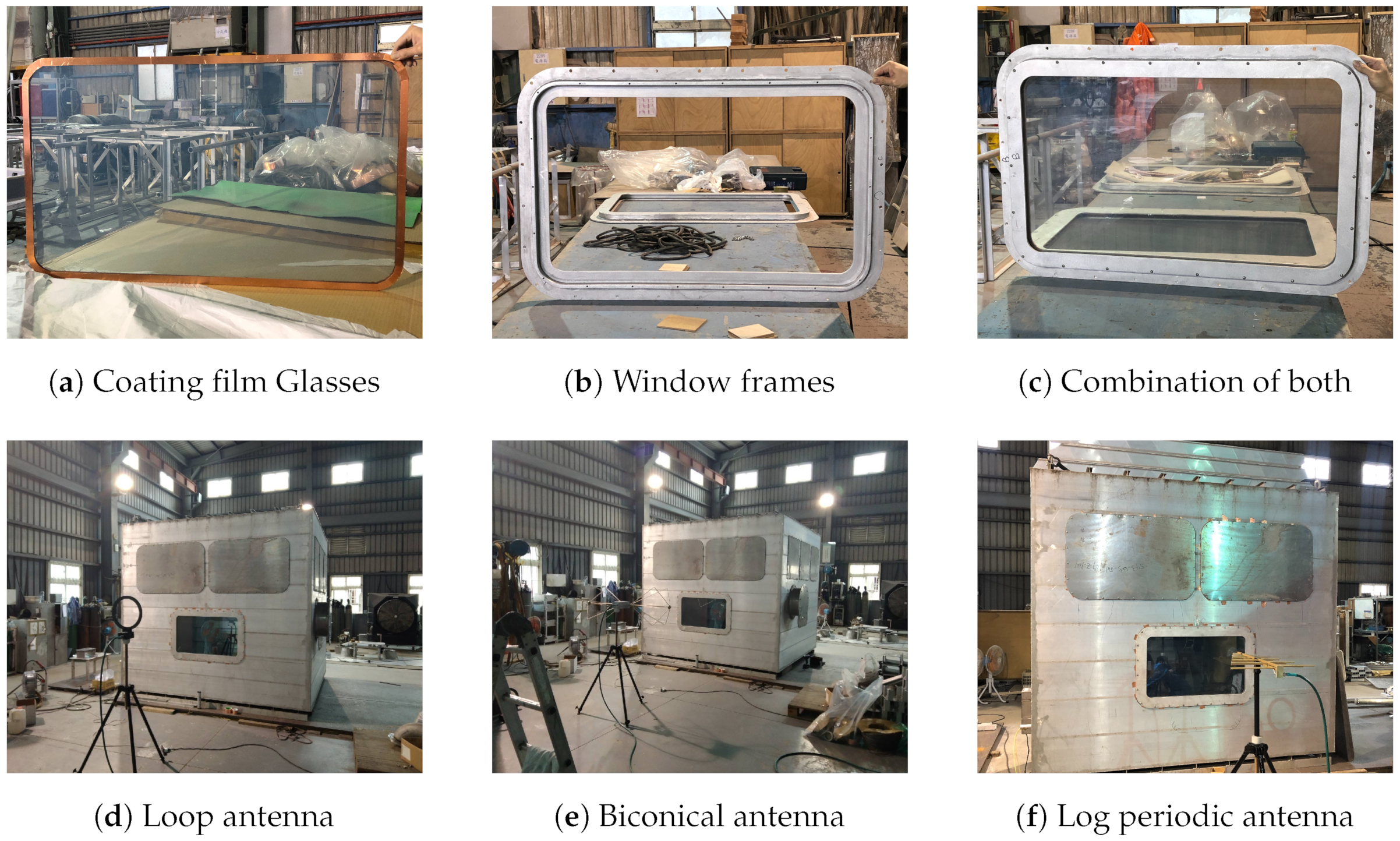

| Parameter | (ns) | FWHM (ns) | k | ||||
|---|---|---|---|---|---|---|---|
| Bell Lab. [21] | 4.6 | 50,000 | 184 | 1.050 | 0.891 | ||
| L. W. Ricketts [22] | 7.8 | 50,000 | 482 | 1.040 | 2.350 | ||
| MIL-STD-2169 [20] | 3.1 | 50,000 | 1.285 | 0.151 | |||
| G. R. Hunt [23] | 5.0 | 50,000 | 200 | 1.060 | 0.979 | ||
| C. E. Baum [24] | 2.4 | 50,000 | ∼24 | 1.114 | 0.107 | ||
| J. Weissman [25] | 4.5 | 50,000 | ∼184 | 1.052 | 0.893 | ||
| Leuthauser [26] | 1.9 | 60,000 | 23.8 | 1.080 | 0.167 | ||
| VG 95371-10 [27] | 0.9 | 65,000 | 24.1 | 1.085 | 0.196 | ||
| IEC 61000-2-9 [28] | 2.5 | 50,000 | 23.0 | 1.300 | 0.114 | ||
| MIL-STD-464D [29] | 2.5 | 50,000 | 23.0 | 1.300 | 0.114 |
| Equipment | Characteristics |
|---|---|
| Power Amplifier | 9 kHz∼1 GHz power output |
| Network Analyzers | Frequency range: 9 kHz∼8.5 GHz |
| Fiber Optical Link (Transmitter & Receiver) | Transmission of analog electric signals from 80 Hz to 3.5 GHz over long distance |
| Fiber optic cables | Diameter: 3 mm, Length: 500 m |
| Loop Antenna | Frequeccy range: 1 kHz∼30 MHz |
| Biconical Antenna | Frequency range: 20∼300 MHz |
| Log Periodic Antenna | Frequency range: 80 MHz∼4 GHz |
| Equipment | Dimension | Min. Wavelength | Min. Far Field Regions |
|---|---|---|---|
| Loop Antenna | Diameter: 12 in. | 15 m | 0.0124 m |
| Biconical Antenna | W × H: 51.6 × 20.1 in. | 3 m | 1.1452 m |
| Log Periodic Antenna | L × W × D: 33.7 × 26 × 2.5 in. | 0.3 m | 2.9075 m |
| Parameter | Sample A | Sample B | Sample C |
|---|---|---|---|
| transmittance | 77% | 74% | 76% |
| sheet resistance () | 6.8 | 6.4 | 6.5 |
| film thickness (nm) | ∼310 | ∼390 | ∼350 |
| resistivity (cm) | |||
| conductivity (S/cm) |
Disclaimer/Publisher’s Note: The statements, opinions and data contained in all publications are solely those of the individual author(s) and contributor(s) and not of MDPI and/or the editor(s). MDPI and/or the editor(s) disclaim responsibility for any injury to people or property resulting from any ideas, methods, instructions or products referred to in the content. |
© 2023 by the authors. Licensee MDPI, Basel, Switzerland. This article is an open access article distributed under the terms and conditions of the Creative Commons Attribution (CC BY) license (https://creativecommons.org/licenses/by/4.0/).
Share and Cite
Cheng, C.-M.; Chen, Y.-H.; Lin, S.-Y.; Chao, S.-D.; Tsai, S.-F. Study on Shielding Effectiveness of High Transmittance Coating Film Glasses against Electromagnetic Pulse. Technologies 2023, 11, 175. https://doi.org/10.3390/technologies11060175
Cheng C-M, Chen Y-H, Lin S-Y, Chao S-D, Tsai S-F. Study on Shielding Effectiveness of High Transmittance Coating Film Glasses against Electromagnetic Pulse. Technologies. 2023; 11(6):175. https://doi.org/10.3390/technologies11060175
Chicago/Turabian StyleCheng, Che-Min, Yu-Hsin Chen, Sheng-Yi Lin, Sheng-Der Chao, and Shun-Feng Tsai. 2023. "Study on Shielding Effectiveness of High Transmittance Coating Film Glasses against Electromagnetic Pulse" Technologies 11, no. 6: 175. https://doi.org/10.3390/technologies11060175
APA StyleCheng, C.-M., Chen, Y.-H., Lin, S.-Y., Chao, S.-D., & Tsai, S.-F. (2023). Study on Shielding Effectiveness of High Transmittance Coating Film Glasses against Electromagnetic Pulse. Technologies, 11(6), 175. https://doi.org/10.3390/technologies11060175







